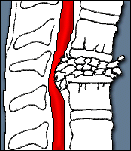The nervous system includes the brain, spinal cord and spinal nerves. The brain sends and receives messages or signals to and from the body. The spinal cord is a rope-like bundle of nerves. It runs inside the backbone from the neck to the low back. Messages travel to and from the brain by way of the spinal cord.
Spinal nerves branch off the spinal cord. The nerves carry messages of “feelings” (sensation) and messages that make muscles move. A spinal cord injury blocks the messages below the level of injury. This means messages about movement, feeling, bowel and bladder control, sexual function, breathing, temperature and blood pressure control can be blocked by a spinal cord injury.
It depends on the level (location) and completeness of injury as to what types of symptoms might be present.
Complete or Incomplete Spinal Cord Injury
 Complete injuries cause damage “through” the spinal cord at the specific level of injury. A complete injury can be defined as having no movement or feeling in the areas around the buttocks or rectum.
Complete injuries cause damage “through” the spinal cord at the specific level of injury. A complete injury can be defined as having no movement or feeling in the areas around the buttocks or rectum.
When the injury is “complete,” a person may have some movement or feeling up to 3 levels below the level of injury. Keep in mind that it is also possible not to have any feeling or movement below the level of injury. Each person and each injury are different.
 If the injury is incomplete, there is only partial damage to the cord. Some feeling or movement remains below the level of injury and in the buttocks/ rectal area. There can be varying degrees of incompleteness. The amount of movement/feeling is determined by the location of the injury and how much damage has been done to the cord. Each person and each injury are different.
If the injury is incomplete, there is only partial damage to the cord. Some feeling or movement remains below the level of injury and in the buttocks/ rectal area. There can be varying degrees of incompleteness. The amount of movement/feeling is determined by the location of the injury and how much damage has been done to the cord. Each person and each injury are different.
Levels of Spinal Cord Injury
 Levels of injury are usually talked about in reference to the location and number of the affected spinal nerve. For example, if the injury is in the neck area, it is called a cervical injury.
Levels of injury are usually talked about in reference to the location and number of the affected spinal nerve. For example, if the injury is in the neck area, it is called a cervical injury.
There are 8 pairs of spinal nerves in the cervical area and they are numbered 1 – 8. So, if the injury affected spinal nerve 5 in the neck area, the injury would be called “C-5.” The “C” stands for “cervical” and the “5” stands for the fifth nerve in that area.
If there is an injury in the cervical area, it results in tetraplegia/quadriplegia. This means there is limited or absent feeling or movement below the shoulders/neck.
There are 12 pairs of spinal nerves in the thoracic area. They are numbered 1-12. So, if the injury affected spinal nerve 10 in the thoracic area, the injury would be called “T-10”. The “T” stands for “thoracic” and the “10” stands for the tenth nerve in that area.
Injuries lower in the spinal cord, thoracic area or lower, result in paraplegia.This means there is limited or absent feeling or movement in the chest and below.
There are also 5 pairs of Lumber and 5 pairs of Sacral spinal nerves. Injuries in these areas would start with either an “L” for “lumbar” or an “S” for “sacral” and be followed with the number of the affected nerve.
For example, a person might have an “L2” injury. This means the injury happened to the second nerve in the lumbar area. Likewise, an S3 injury would mean there was an injury to the third nerve in the sacral area.
| Spinal Nerves | Muscle Function |
|---|---|
| C-1 to C-2 | Neck and face movement |
| C-3 to C-4 | Diaphragm movement (breathing muscle) |
| C-5 | Elbow bending |
| C-6 | Wrist extension (bending wrist upward) |
| C-7 | Elbow straightening |
| C-8 | Finger movement |
| T-1 to T-2 | Control of chest, abdomen (stomach area) & back muscles |
| L-1 to L-2 | Hip bend (flex) |
| L-3 | Knee straightening |
| L-4 | Bend foot upward |
| L-5 | Extended toes |
| S-1 | Bend foot down toward floor |
| S-2 through S-4 | Perineal area (areas for urinating & bowel movements) |
Spinal cord injuries affect many aspects of life. Issues range from general physical care to coping and sexuality. Some other examples may include problems with breathing, blood pressure control, using the bathroom and general safety depending on the level and type of injury. Always remember that each person and each injury is different. The following lessons in this course will explain each area in more detail.




